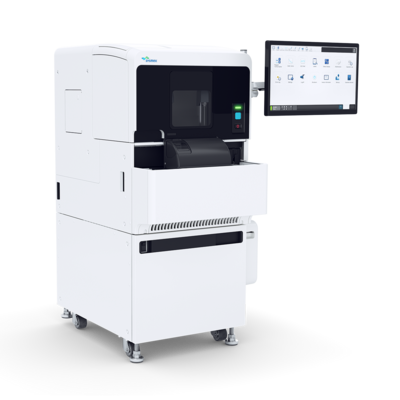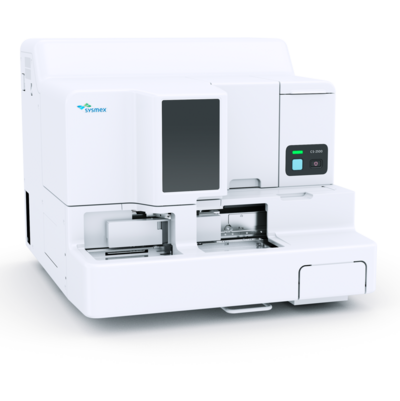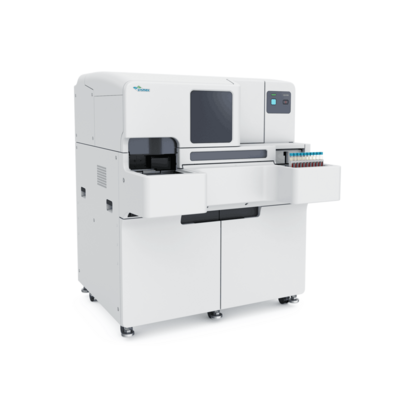Haemostasis reagent solutions
Sysmex, collectively with Sysmex Group company HYPHEN BioMed, and our strategic business partner Siemens Healthineers, deliver a holistic approach to haemostasis testing by offering all of the components required to meet different needs – from analysers of various sizes to assays for routine and specialty testing, complemented by Sysmex’s renowned service and knowledge to assist users in making the most of their investment.
These partnerships enable us to provide our customers around the world with innovative technologies and best-in-class haemostasis solutions needed to support increasing testing volumes, whilst providing accurate results for improved patient care.
I n particular, this alliance enables us to offer our broad haemostasis reagent portfolio: solutions that, in combination with our analysers, provide more effective ways to assist clinicians in the diagnosis, monitoring and management of disease.
A holistic approach
HYPHEN BioMed – a company of the Sysmex Group
To advance the specialist role in haemostasis, HYPHEN BioMed joined the Sysmex Group in 2010, enabling us to provide a comprehensive line of specialty reagents to complement our existing Siemens haemostasis reagent portfolio. HYPHEN BioMed specialises in the development, manufacturing and distribution of in vitro diagnostic and research reagents for exploring thrombosis, haemostasis and autoimmunity. These innovative and value-adding solutions are provided to hospital laboratories and research institutions worldwide through an extensive distribution network.
Siemens Healthineers – strategic business partner
Since 1995, Sysmex Corporation and Siemens Healthineers have continued their long-standing global partnership and collaboration, working closely to drive activities of haemostasis product development that streamline and optimise testing in laboratories globally. Siemens offer reagents for all areas of haemostasis. These reagents are globally recognised for their quality, and thanks to the certified application protocols with Sysmex analysers show optimal performance that ensures reliable and high-quality results for our clients.
Platelet function
When suspecting primary haemostatic disorders in a patient with bleeding symptoms and thrombocytopenia and von Willebrand disease (VWD) have been excluded, it is currently recommended to carry out laboratory investigations of platelet function. [1] The assessment of platelet aggregation provides valuable information in order to diagnose inherited platelet disorders (thrombasthenia, Bernard-Soulier syndrome, etc.) or acquired platelet function defects. Platelet aggregation tests can also be performed to monitor and evaluate the effectiveness of antiplatelet medication, which is often performed in specialised labs.
Platelet aggregation testing uses light transmission aggregometry (LTA), which is considered as the gold standard for testing platelet function. LTA measures the transmission of light through a sample of platelets in suspension (platelet-rich plasma, PRP), which increases when platelets are aggregated by an agonist. [1]
ADP, epinephrine, collagen, arachidonic acid and ristocetin are the recommended agonists to investigate platelet function. [2] Different agonists can be used, according to the clinical status of the patient.
Both automated and semi-automated assays are available to assess platelet function, however, even though semi-automated assays are more accessible, they can be labour-intensive and assay standardisation is a challenge.
Automated and standardised measurements of these agonists can be achieved as easily as other routine tests by utilising Sysmex’s Revohem platelet aggregation reagents together with the automated platelet aggregation function integrated in Sysmex CS-5100, CS-2400/2500 and CS-2000i/2100i analysers.
For more information on the Revohem reagents, please go to the document slider and download our ‘Automated platelet aggregation testing’ flyer, or contact your local Sysmex representative.
Thrombosis management (DOACS)
Heparin and warfarin have been extensively used over the past half century for thrombosis management. However, their highly variable dose responses and need for close laboratory monitoring has driven the search for new anticoagulant drugs with more predictable effects, eliminating the need for laboratory monitoring and frequent individual patient dosage adjustments. Several new direct oral anticoagulants (DOACs) have been developed with the following advantages: oral administration with predictable pharmacokinetics and dose response, wide therapeutic window, shorter half-life, little interference with food and other drugs, and no need for routine monitoring. The DOACs are prescribed for many preventive or curative thromboembolic indications, including the prevention of stroke in patients with non-valvular atrial fibrillation – where need is increasing with the aging population.
DOACs can be classified into two types: direct factor Xa inhibitors (DiXaIs) such as Rivaroxaban, Apixaban and Edoxaban, and direct thrombin inhibitors (DTIs) such as Dabigatran. The heparins and their analogues are catalytic inhibitors, which require the presence of antithrombin (AT) for their activity while DOACs directly inhibit target coagulation serine esterase (thrombin for DTIs or factor Xa for DiXaIs).
The major difference between DOACs and classic anticoagulants in relation to monitoring are:
1. Unlike heparin and its analogues, DOACs do not require regular monitoring, unless in specific patients and under certain clinical circumstances such as: [3, 4]
- unexplained bleeding or recurrent thrombosis despite a correct intake of anticoagulant therapy
- suspected overdose
- admission to intensive care or emergency units (unknown treatment)
- control of bleeding risk before an emergency surgery in individuals anticoagulated with DOACs
- impaired kidney or liver function and/or patients with multiple therapies (long-term treatment)
- to exclude any risk of progressive drug accumulation resulting from a lack of clearance
- to further explore the laboratory findings of unexplained prolonged clotting times
2. The presence of DOACs in plasma affects the results of coagulation tests, routine screening and specialty assays in a variable manner. Liquid chromatography/mass spectrometry (LC/MS) is the reference method used for DOAC concentration measurement in plasma; however, this time-consuming and costly test is available only in highly specialised laboratories. Therefore, it is important to have dedicated tests readily available that are fast, sensitive and quantitatively measure DOAC concentrations in plasma.
Sysmex offers a choice of assays including a complete range of dedicated, assay-specific calibrators and controls, depending on the lab’s needs.
Haemophilia
Haemophilia is a congenital, single coagulation factor deficiency marked by anatomic bleeding, with an incidence of 1 in 10,000 individuals where 85% are factor VIII (FVIII) deficient (haemophilia A) and 14% are factor IX (FIX) deficient (haemophilia B). The disorder may be due to absent or reduced function, or production of an aberrant non-functional molecule of FVIII or FIX. [5] The disorder usually occurs in males and is transmitted by females who carry the abnormality on their X chromosome. However, about one third of all cases is caused by a spontaneous mutation. [6, 7]
Haemophilia is the most frequent haemorrhagic medical condition in children, due to significant haemorrhage risks, which can be life-threatening in the absence of immediate on-demand treatment. Therefore, laboratory assays play an important role in the detection and management of haemophilia.
The care management of haemophiliacs is changing with the emergence of new treatments. The new therapeutic areas make it necessary to review the present biological and clinical monitoring, where chromogenic FVIII and FIX assays have the advantage of a more homogeneous reactivity to the various FVIII or FIX products available. [8] Depending on the situation, assays with different principles should be considered.
Sysmex offers a complete product portfolio for haemophilia diagnosis and management, which ranges from screening to specialty assays including chromogenic FVIII and FIX assays.
Thrombophilia
Thrombophilia refers to the conditions where there is an increased tendency to develop venous or arterial thrombosis. Thrombophilia can be hereditary and/or acquired. [9-11]
Inherited thrombophilia includes:
- antiphospholipid syndrome (APS), the most common acquired thrombophilia
- gain-of-function variants (e.g. factor V Leiden [FVL] or prothrombin G20210A)
- loss of function of the natural anticoagulants, such as antithrombin (AT), protein C (PC), and/or protein S (PS).
Although approximately 50% of patients presenting with venous thromboembolism (VTE) are found to have thrombophilia [12], it remains only one of numerous possible elements that determine the risk of thrombosis. In general, thrombophilia testing is ordered to predict VTE recurrence, to decide whether patients should remain on long-term anticoagulant therapy, to manage asymptomatic family members of patients with confirmed thrombophilia, and to satisfy patient curiosity as to an underlying explanation for a thrombotic event.
However, the adverse effects of the unnecessary ordering and poor interpretation of thrombophilia assays should also be considered, such as clinicians withholding anticoagulants from patients at a high risk of thrombosis and in turn exposing them to the risk of a thrombotic event, providing anticoagulants to patients at a low risk of thrombosis increasing their risk of bleeding, and the financial cost and emotional strain of patients.
Therefore, thrombophilia tests should be ordered in a highly selective manner and only when the expected results will alter patient management.
To address the problem of overdiagnosis, evidence-based guidelines for both inherited and acquired thrombophilia screening have been published, stating recommendations as to specific clinical conditions, the timing of thrombophilia testing and types of testing [9-11]. Although it can be complex and challenging to implement guidelines in clinical settings, many studies are continuously being published to claim the importance of guideline implementation in order to further improve patient care and reduce costs. [12, 13]
Sysmex provides assays that cover the thrombophilia panel and are compliant with recommendations. In doing so, we aim to support laboratories trying to establish optimised decision trees for the risk of thrombosis in adherence to guidelines.
Lupus anticoagulants coming soon
References
Platelet function
[1] Cattaneo M, Cerletti C, Harrison P, Hayward CPM, Kenny D, Nugent D, Nurden P, Rao AK, Schmaier AH, Watson SP, Lussana F, Pugliano MT, Michelson AD. Recommendations for the standardization of light transmission aggregometry: a consensus of the working party from the platelet physiology subcommittee of SSC/ISTH. J Thromb Haemost 2013; 11:1183–9.
[2] Harrison P, Mackie I, Mumford A, Briggs C, Liesner R, Winter M, Machin S. Guidelines for the laboratory investigation of heritable disorders of platelet function. Br J Haematol 2011; 155:30–44.
Thrombosis management (DOACS)
[3] Amiral J, Dunois C, Amiral C, Seghatchian J. An update on laboratory measurements of Dabigatran: Smart specific and calibrated dedicated assays for measuring anti-IIa activity in plasma. Transfus Apher Sci. 2016 Jun; 54(3):428-37.
[4] Amiral J, Dunois C, Amiral C, Seghatchian J. Anti-Xa bioassays for the laboratory measurement of direct Factor Xa inhibitors in plasma, in selected patients. Transfus Apher Sci. 2016 Oct; 55(2):249-61.
Haemophilia
[5] White GC 2nd, Rosendaal F, Aledort LM, Lusher JM, Rothschild C, Ingerslev J, et al. Definitions in hemophilia. Recommendation of the scientific subcommittee on Factor VIII and Factor IX of the scientific and standardization committee of the International Society on Thrombosis and Hemostasis. Thromb Hemost. March 2001; 85(3):560.
[6] National Hemophilia Foundation. Hemophilia A. [online] Available at: www.hemophilia.org/Bleeding-Disorders/Types-of-Bleeding-Disorders/Hemophilia-A
[Accessed: 27 Sept 2018]
[7] National Hemophilia Foundation. Hemophilia B. [online] Available at: www.hemophilia.org/Bleeding-Disorders/Types-of-Bleeding-Disorders/Hemophilia-B
[Accessed: 27 Sept 2018]
[8] Amiral J, Seghatchian J. Usefulness of chromogenic assays for potency assignment and recovery of plasma-derived FVIII and FIX concentrates or their recombinant long acting therapeutic equivalents with potential application in treated pediatric hemophiliac patients. Transfus Apher Sci. 2018 Jun; 57(3):363-69.
Thrombophilia
[9] Baglin T, Gray E, Greaves M, Hunt BJ, Keeling D, Machin S, Mackie I, Makris M, Nokes T, Perry D, Tait RC, Walker I, Watson H; British Committee for Standards in Haematology. Clinical guidelines for testing for heritable thrombophilia. Br J Haematol 2010; 149:209–20.
[10] Van Cott E, Laposata M, Prins M. Laboratory evaluation of hypercoagulability with venous or arterial thrombosis. Arch Pathol Lab Med 2002; 126:1281–95.
[11] Pengo V, Tripodi A, Reber G, Rand J, Ortel TL, Galli M, De Groot PG; Subcommittee on Lupus Anticoagulant/Antiphospholipid Antibody of the Scientific and Standardisation Committee of the International Society on Thrombosis and Haemostasis. Update of the guidelines for lupus anticoagulant detection. J Thromb Haemost 2009; 7:1737–40.
[12] Kwon AJ, Roshal M, DeSancho MT. Clinical adherence to thrombophilia screening guidelines at a major tertiary care hospital. J Thromb Haemost 2016; 14:982–6.
[13] Stevens SM, Woller SC, Bauer KA, Kasthuri R, Cushman M, Streiff M, Lim W, Douketis JD. Guidance for the evaluation and treatment of hereditary and acquired thrombophilia. J Thromb Thrombolysis. 2016 Jan; 41(1):154-64.
Sysmex UK LTD
Sysmex House
Garamonde Drive
Wymbush
Milton Keynes
MK8 8DF
0333 320 3460
Product documents
Regulatory Documents
Regulatory documents, such as Instructions for Use, can be accessed with a valid My Sysmex login:
Go to My Sysmex![[.CO.UK-en United Kingdom (english)] [.CO.UK-en United Kingdom (english)]](/fileadmin/_processed_/d/8/csm_haemostasis_reagents_800x800_0000_Group-Platelet-Revohem_3bf8193127.png)
![[.CO.UK-en United Kingdom (english)] [.CO.UK-en United Kingdom (english)]](/fileadmin/_processed_/2/7/csm_haemostasis_reagents_800x800_0001_Group-Platelet-Revohem_c4c9cf2b80.png)
![[.CO.UK-en United Kingdom (english)] [.CO.UK-en United Kingdom (english)]](/fileadmin/_processed_/1/6/csm_Haemostasis_Reagents_800x800_0002_Dade-Ci-Trol1_7043a4162d.png)
![[.CO.UK-en United Kingdom (english)] [.CO.UK-en United Kingdom (english)]](/fileadmin/_processed_/5/3/csm_Haemostasis_Reagents_800x800_0003_Dade_Thrombin.png_0d21eb4eba.png)
![[.CO.UK-en United Kingdom (english)] [.CO.UK-en United Kingdom (english)]](/fileadmin/_processed_/7/0/csm_Haemostasis_Reagents_800x800_0004_Dade_Innovin_OUS_a8a66dfa9a.png)
![[.CO.UK-en United Kingdom (english)] [.CO.UK-en United Kingdom (english)]](/fileadmin/_processed_/c/5/csm_Haemostasis_Reagents_800x800_0005_Dade_Actin-FSL_8519b46100.png)
![[.CO.UK-en United Kingdom (english)] [.CO.UK-en United Kingdom (english)]](/fileadmin/_processed_/b/9/csm_Haemostasis_Reagents_800x800_0006_Dade_Actin-FS_0241c79b0c.png)
![[.CO.UK-en United Kingdom (english)] [.CO.UK-en United Kingdom (english)]](/fileadmin/_processed_/4/8/csm_Haemostasis_Reagents_800x800_0010_06_Test_Thrombin_cbbc1b4879.png)
![[.CO.UK-en United Kingdom (english)] [.CO.UK-en United Kingdom (english)]](/fileadmin/_processed_/9/8/csm_Haemostasis_Reagents_800x800_0011_Platelet-Collagen-COL-isolated_b4173490b7.png)
![[.CO.UK-en United Kingdom (english)] [.CO.UK-en United Kingdom (english)]](/fileadmin/_processed_/6/1/csm_Revohem_Anti-Xa_a482387559.png)
![[.CO.UK-en United Kingdom (english)] [.CO.UK-en United Kingdom (english)]](/fileadmin/_processed_/8/4/csm_Revohem_Apixaban_Control_YAX-100A_67ea16ad7b.png)
![[.CO.UK-en United Kingdom (english)] [.CO.UK-en United Kingdom (english)]](/fileadmin/_processed_/e/2/csm_Revohem_Edoxaban_869d65005a.png)
![[.CO.UK-en United Kingdom (english)] [.CO.UK-en United Kingdom (english)]](/fileadmin/_processed_/b/a/csm_Revohem_Rivaroxaban_Control_YRX_4995c510ee.png)
![[.CO.UK-en United Kingdom (english)] [.CO.UK-en United Kingdom (english)]](/fileadmin/_processed_/d/8/csm_haemostasis_reagents_800x800_0000_Group-Platelet-Revohem_5b65a061b4.png)
![[.CO.UK-en United Kingdom (english)] [.CO.UK-en United Kingdom (english)]](/fileadmin/_processed_/2/7/csm_haemostasis_reagents_800x800_0001_Group-Platelet-Revohem_70bd070880.png)
![[.CO.UK-en United Kingdom (english)] [.CO.UK-en United Kingdom (english)]](/fileadmin/_processed_/1/6/csm_Haemostasis_Reagents_800x800_0002_Dade-Ci-Trol1_eb8e29165b.png)
![[.CO.UK-en United Kingdom (english)] [.CO.UK-en United Kingdom (english)]](/fileadmin/_processed_/5/3/csm_Haemostasis_Reagents_800x800_0003_Dade_Thrombin.png_2bf845c25e.png)
![[.CO.UK-en United Kingdom (english)] [.CO.UK-en United Kingdom (english)]](/fileadmin/_processed_/7/0/csm_Haemostasis_Reagents_800x800_0004_Dade_Innovin_OUS_7e4079f91e.png)
![[.CO.UK-en United Kingdom (english)] [.CO.UK-en United Kingdom (english)]](/fileadmin/_processed_/c/5/csm_Haemostasis_Reagents_800x800_0005_Dade_Actin-FSL_cb96b9d588.png)
![[.CO.UK-en United Kingdom (english)] [.CO.UK-en United Kingdom (english)]](/fileadmin/_processed_/b/9/csm_Haemostasis_Reagents_800x800_0006_Dade_Actin-FS_a4f45efad3.png)
![[.CO.UK-en United Kingdom (english)] [.CO.UK-en United Kingdom (english)]](/fileadmin/_processed_/4/8/csm_Haemostasis_Reagents_800x800_0010_06_Test_Thrombin_3bdb3f67b1.png)
![[.CO.UK-en United Kingdom (english)] [.CO.UK-en United Kingdom (english)]](/fileadmin/_processed_/9/8/csm_Haemostasis_Reagents_800x800_0011_Platelet-Collagen-COL-isolated_16c55e5234.png)
![[.CO.UK-en United Kingdom (english)] [.CO.UK-en United Kingdom (english)]](/fileadmin/_processed_/6/1/csm_Revohem_Anti-Xa_a82c4211b6.png)
![[.CO.UK-en United Kingdom (english)] [.CO.UK-en United Kingdom (english)]](/fileadmin/_processed_/8/4/csm_Revohem_Apixaban_Control_YAX-100A_3b7f29af38.png)
![[.CO.UK-en United Kingdom (english)] [.CO.UK-en United Kingdom (english)]](/fileadmin/_processed_/e/2/csm_Revohem_Edoxaban_55a83b20ea.png)
![[.CO.UK-en United Kingdom (english)] [.CO.UK-en United Kingdom (english)]](/fileadmin/_processed_/b/a/csm_Revohem_Rivaroxaban_Control_YRX_f56a8b34f2.png)



